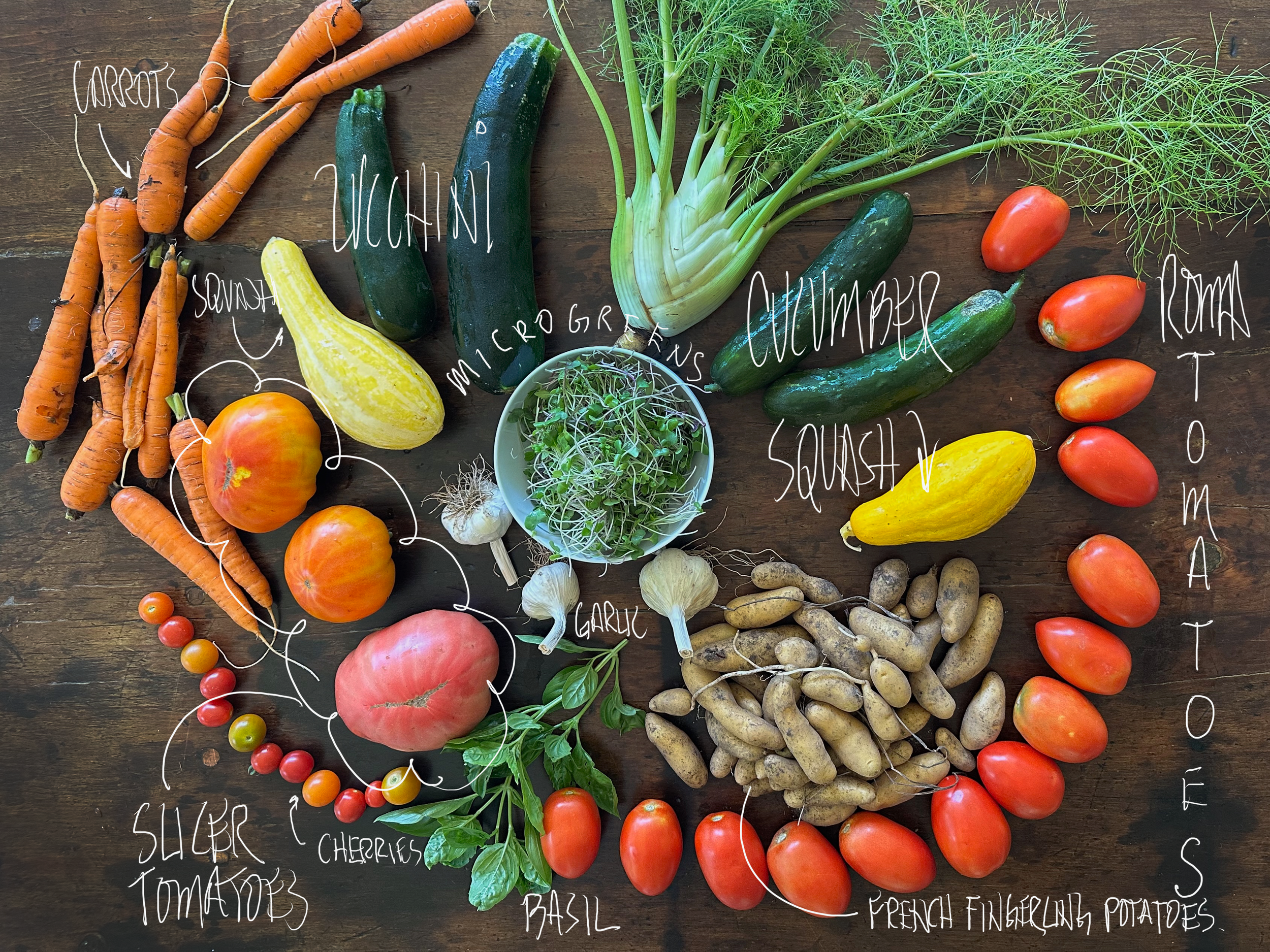2025 Season | Week 13
Nobody Going to Break Our Stride
We've had a gang of raccoons and groundhogs terrorizing the tomato house this week. I love animals, but not inside the fence. So, the word is out around the farm - STAY OUT OF THE GARDEN!
This week's harvest looks like the one we strive for every week. A rich and diverse variety of 8-12 veggies in quantities that you can make delicious and healthy meals. Charlotte and I have been experimenting with the French fingerling potatoes (roasted with garlic and onion - or smashed and topped with Parmesan and baked) and with the Roma tomatoes (great roasted and in a sauce - use your garlic with it and then garnish with basil!) If anyone is interested in canning some tomatoes, please let us know. We'll pick one or two members each week to pick a bushel or so.
Have a good week.
-
CARROTS 101 - Crunchy, tasty, and highly nutritious, carrots are one of our favorite root vegetables. Carrots are a great source of beta carotene, fiber, vitamin K1, potassium, and antioxidants! We’re used to seeing orange carrots, but did you know carrots come in a variety of colors like yellow, white, red, and even purple? Both the root and the greens are edible - the leaves make for a great garnish or addition to pesto. The greens have a slightly bitter taste that compliments the sweetness of the root.
EAT NOW - Because we don’t use pesticides, our carrots don’t need to be peeled. Simply rinse and scrub any dirt before use. Eaten raw, carrots are great whole, julienned, speared, or chopped. Carrots can be boiled, sautéd, stir fried, or even air fried! Fresh carrot tops can be chopped into a green salad or stir-fry too! The greens can also be dried and used as an herb like parsley.
OR LATER - To avoid “floppy carrots,” remove the green tops as soon as you can, leaving about an inch of stems. Save the greens separately. Then, place root in a bag in the fridge or in a bin of water (like celery) to keep them crisp, changing out the water every few days. Uncut carrots will last in the fridge for up to 4 weeks. They can also be chopped, then blanched and placed in an airtight container in the freezer to keep longer. Store the tops in a separate bag in the fridge. Or put them in a plastic Ziplock in your freezer and use them to make DIY vegetable or chicken stock.
To blanch, bring a pot of lightly salted water to a rolling boil. While you wait for boil, prepare an ice bath. Once boiling, drop veggies into water - water should return to boil within a minute otherwise you have too much veg for the water. Once boil has returned, cook for 1-5 min until veg has a vibrant color. Immediately put into ice bath to stop cooking.
RECIPIES
-
Cucumber 101
Crisp, cool, and incredibly refreshing, cucumbers are a staple summer vegetable (technically a fruit!) known for their high water content and mild flavor. They belong to the gourd family and are rich in hydration, vitamin K, and antioxidants. Whether you choose slicing cucumbers or smaller pickling varieties, they add crunch and freshness to almost any dish.Eat Now
Enjoy cucumbers raw—just wash, slice, and snack. Add to salads, sandwiches, or enjoy with a sprinkle of sea salt or a splash of vinegar. For a cooling treat, slice into water with lemon and mint for a spa-style drink.Eat Later
Store whole cucumbers in the fridge, preferably in the crisper drawer, for up to a week. Once cut, wrap tightly in plastic or place in an airtight container to maintain moisture and crunch. Avoid storing near ethylene-producing fruits like bananas, which can cause premature spoilage.Recipes
Cucumber Salad: Toss sliced cucumbers with red onion, rice vinegar, sesame oil, and a pinch of sugar for a quick Asian-inspired salad.
Tzatziki Sauce: Grate cucumber and mix with Greek yogurt, garlic, lemon, and dill for a tangy, creamy dip.
Chilled Cucumber Soup: Blend cucumbers with yogurt, mint, and a splash of lemon juice for a refreshing summer soup.
-
Fennel
FENNEL 101
Fennel is a crisp, aromatic vegetable with a mild licorice flavor and a satisfying crunch. It's part of the carrot family but looks more like celery with its bulbous base, layered stalks, and feathery fronds. Both the bulb and the fronds are edible and versatile—great raw or cooked.EAT NOW
Slice the bulb thin and toss it into salads for a fresh, anise-sweet crunch. Shave it over pizza or tuck it into sandwiches for extra brightness. The fronds make a beautiful garnish and can be blended into dressings or sprinkled like herbs.OR LATER
Fennel mellows and sweetens as it cooks. Roast wedges alongside chicken or fish, sauté with onions for a simple side, or braise with broth and wine for a soft, savory treat. It stores well in the fridge, unwashed and wrapped in a damp towel, for up to a week—so you can enjoy it fresh today and tender tomorrow. -
101
French Fingerlings are small, slender heirloom potatoes with rose-pink skin and creamy yellow flesh, often streaked with red. Their waxy texture and nutty, earthy flavor make them a favorite among chefs and home cooks alike. They're excellent roasted, boiled, or pan-fried and hold their shape beautifully in salads.EAT NOW
Store them in a cool, dark place (not the fridge) and rinse just before cooking. Enjoy them roasted with herbs, boiled with butter, or sliced into a warm potato salad.EAT LATER
Keep them in a breathable container in a pantry or cellar—avoid plastic bags. They’ll keep for several weeks if stored properly. Sprouting or greening? It’s time to compost.RECIPES
Garlic-Herb Roasted Fingerlings: Toss with olive oil, minced garlic, rosemary, and sea salt. Roast at 425°F until golden and crispy.
Warm Dijon Potato Salad: Boil, slice, and toss with Dijon vinaigrette, shallots, and fresh dill.
Skillet Hash: Pan-fry diced fingerlings with onions, peppers, and a fried egg on top.
-
Fresh Garlic 101
Fresh-harvested garlic, also known as “wet” or “green” garlic, is garlic that’s been pulled from the ground before it’s fully cured. Unlike the dry, papery bulbs you find in the store, fresh garlic has moist skins, juicy cloves, and sometimes green stalks still attached. The flavor is milder and more delicate than cured garlic, with a slightly grassy, almost sweet note—perfect for early summer cooking.Eat Now
Use fresh garlic anywhere you’d use regular garlic, but celebrate its tenderness! Slice or mince the cloves for sautés, salad dressings, or marinades. The juicy cloves melt beautifully into sauces, and the mild flavor makes it a lovely addition raw in dips or spreads. If the stalks are still soft, you can treat them like scallions—chop and toss into stir-fries, soups, or omelets.Eat Later
If you’re not using it right away, store fresh garlic in a cool, dry spot with good airflow. It won’t last as long as cured garlic—typically a few weeks—so keep an eye on it. To preserve the harvest, you can cure the garlic yourself by allowing it to dry for a few weeks, or peel and freeze the cloves for longer storage. Roasting and storing in oil (with proper safety precautions) is another delicious way to enjoy fresh garlic down the road. -
SQUASH 101 - Because of their bland flavor, summer squash lend themselves to many cooking applications, taking on the flavor of whatever they’re cooked with. Try using them as a substitute for rice, pasta or potatoes. Or, slice tender, young squash into salads, stir-fries, or with pasta. The are also great on the grill!
EAT NOW - Gently scrub away dirt. Slice off the tops. Can be roughly chopped, sliced, or grated for a variety of recipes from steamed to stuffed to stir-fried!
OR LATER - Store squash unwashed in a perforated plastic bag in the vegetable bin for about a week and a half. Freeze pureed (seeded) zucchini in Ziplock bags, and grated zucchini for use in breads and muffins.
RECIPE
-
TOMATOES 101 - Probably the most versatile fruit in the garden, tomatoes can be used in countless ways - salsa, gazpacho, sauces, slow roasted, puree and even a bloody Mary. Ours are grown for taste so eat them right out of the crate.
EAT NOW - Store unripe tomatoes upside down on a plate at room temperature until they fully ripen. Wash, pat dry, slice or dice, and enjoy the taste of a real tomato.
OR LATER - Refrigerate any fully ripe tomatoes - allow to come to room temp before serving. To freeze, first blanch and dunk in ice water to cool. Remove stems and core. Transfer to storage bags, seal and place in freezer.
To blanch, bring a pot of lightly salted water to a rolling boil. While you wait for boil, prepare an ice bath. Once boiling, drop veggies into water - water should return to boil within a minute otherwise you have too much veg for the water. Once boil has returned, cook for 1-5 min until veg has a vibrant color. Immediately put into ice bath to stop cooking.
RECIPES




